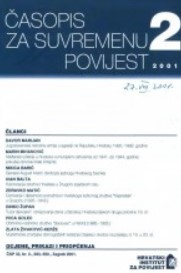Multietničke značajke demografskih kretanja Osijeka i okolice na prijelazu iz 19. u 20. stoljeće
Multiethnic Characteristics of Demographic Movements in Osijek and Its Surroundings at the Turn of the 19th Century
Author(s): Zlata Živaković- KeržeSubject(s): Local History / Microhistory, Social history, Demography and human biology, 19th Century, Pre-WW I & WW I (1900 -1919), Migration Studies, Inter-Ethnic Relations
Published by: Hrvatski institut za povijest
Keywords: Osijek's population; 19th century; Demographic movements; ethnic structure; migrations;
Summary/Abstract: The felling of forests, the building of railway lines, and the development of transportation as a whole, commerce, trades and industry, and the advancement of agricultural practices and other activities drew laborers into the cities and villages of the Kingdom of Croatia and Slavonia. Settlers came not just from other regions of Croatia, but also Bosnia, southern Hungary (Vojvodina), and a substantial number from other lands of the Austro-Hungarian Empire (Germans, Hungarians, Slovaks, Czechs, Jews and others). These demographic movements are representative of the significant growth of population from diverse ethnic origins or affiliations. Significant changes occurred in the settling of cities, as well as villages. Settled nobility, craftsmen, soldiers, villagers and merchants, who purchased or incorporated new properties into existing ones, mixed with the existing Croat population [the number of nobility is negligible]. With the emergence of a modern capitalist economy, zadruga’s disintegrate, properties were divided, and significant changes in agriculture, trades and commerce occurred. These migrations were influenced by numerous factors, especially political and economic ones, and participated in the alteration of many structures, particularly the ethnic structure of the population of Osijek. The total movement of Osijek’s population, and the alteration of its structure were in times of peace, in direct correlation with its economic and social development. The inter-census time periods with the greatest population growth were also time periods of the greatest economic growth. In the census of 1910, Osijek was multi-ethnic with four dominant ethnicities-Croats, Germans, Hungarians and Serbs. At the same time, there was little economic growth in villages, poor horizontal population growth, and a large share of the population was employed in agriculture.
Journal: Časopis za suvremenu povijest
- Issue Year: 33/2001
- Issue No: 2
- Page Range: 475-492
- Page Count: 18
- Language: Croatian

